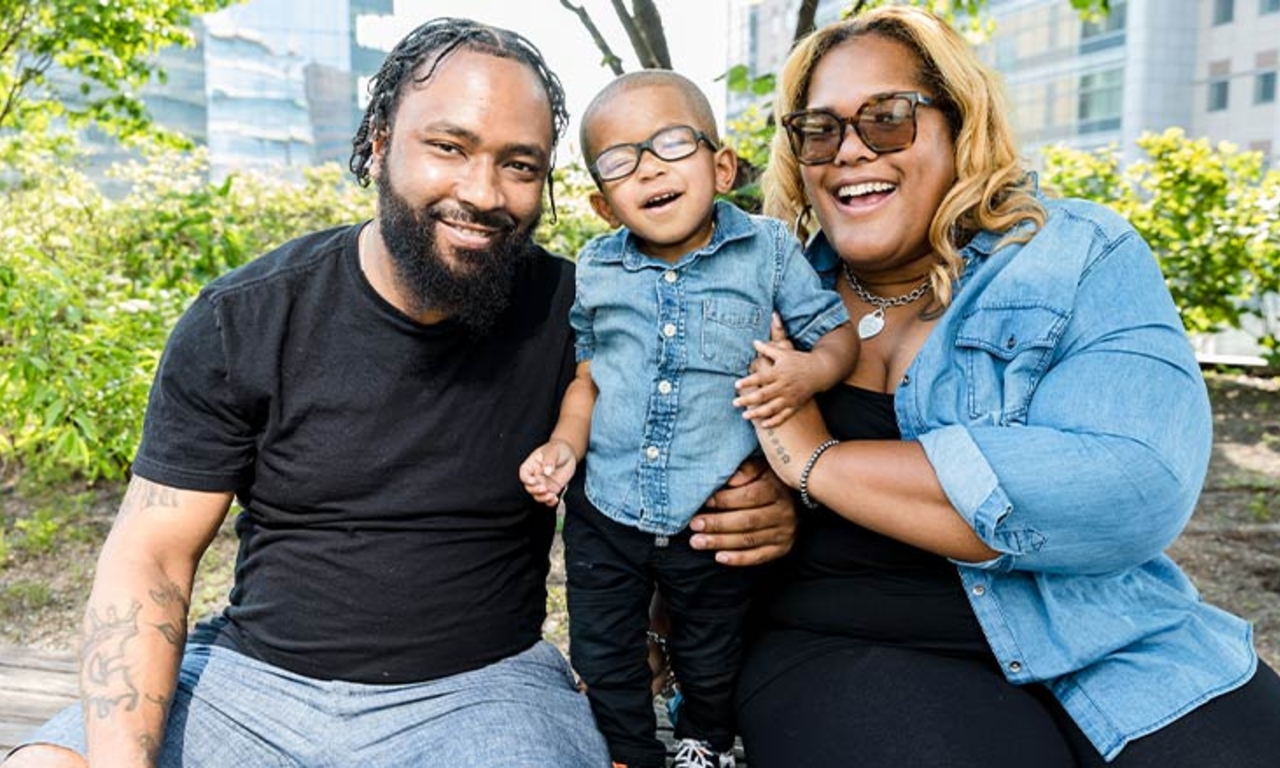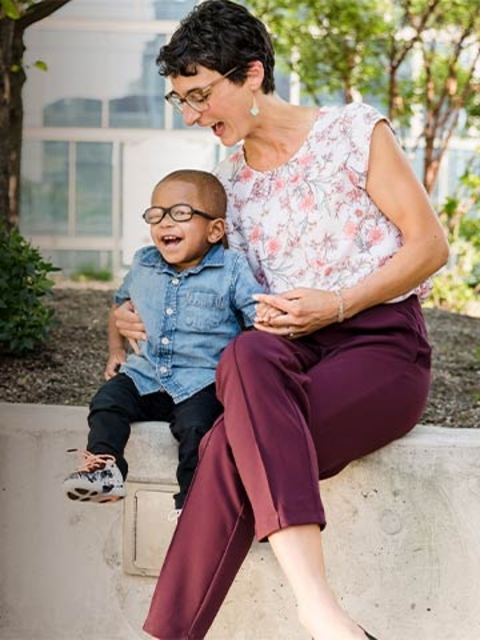Nance Horan Syndrome: Chaz’s Story
Nance Horan Syndrome: Chaz’s Story

Chaz was only two months old when his family learned he was nearly blind. Though the infant could track light, he couldn’t recognize familiar faces. His pediatrician referred the family to Children’s Hospital of Philadelphia (CHOP) for additional testing, where they learned Chaz had congenital cataracts and would need immediate surgery.
Early development
Chaz was born full-term at a community hospital outside Philadelphia. Though a healthy 6 lbs. 8 oz. at birth, his family noticed he didn’t open his eyes much at the hospital — or even after the family returned home to Glenside, PA. “His eyes looked gray — like smoky,” Jazmin recalls. When she and Chris, Chaz’s dad, asked the pediatrician about it, the doctor wasn’t concerned at first. But at 2 months old — at Jazmin’s insistence — the pediatrician referred the family to a pediatric ophthalmologist at CHOP.
They met with William Anninger, MD, who performed a detailed eye examination, conducted tests, and confirmed Chaz had extremely limited vision in both eyes due to congenital cataracts. This condition, which produces a cloudiness in the lens of the eye, is rare in infants — only affecting about two to three babies per 10,000 — but is treatable.
However, to give Chaz the best chance at healthy sight, he would need immediate surgery. “We were scared, but Dr. Anninger was so reassuring,” Jazmin says. “He told us he sees babies with cataracts all the time. ‘We can fix this,’ he told us. ‘After surgery, I’m confident he’ll be able to see.’”
Cataract surgery

Chris, Chaz and Jazmin
Within a week — and right before Christmas 2021 — Chaz underwent cataract surgery at CHOP’s Main Hospital in Philadelphia. Jazmin and Chris waited anxiously through the nearly two-hour surgery to treat both of Chaz’s eyes. “When Dr. Anninger came out to see us after surgery, he told us everything went great,” Jazmin said. “It was such a relief.”
The couple was able to take Chaz home the same day. The baby had cones covering his eyes to protect them while they healed. “He looked like a little bumble bee,” Jazmin says. The family was given instructions on how to care for Chaz’s eyes until a follow-up visit with Dr. Anninger a few days later.
“We were at the hospital when the cones came off and Chaz opened his eyes. He fast blinked a few times, and immediately reached out to touch our faces,” Jazmin said. “We were talking to him, and you could tell he was really seeing us for the first time. It was such a beautiful moment.”
Though surgery treated the cataracts, Chaz’s vision was still limited. He would need contacts — and later glasses — to help him see more clearly. Caring for an infant with contacts was challenging, but thankfully, CHOP staff coached the parents on how best to care for Chaz and his contacts, including removing them weekly for cleaning.
New symptom leads to more testing
At Chaz’s second follow-up visit with ophthalmology, eye tests revealed the pressure in Chaz’s eyes was abnormally high. High eye pressure can cause pain in and around the eye, blurred vision, blind spots, irritation, and headaches. It can also be an early sign of glaucoma. Because Chaz was too young to say how he was feeling or what he could see, his parents and doctors had to rely on the baby’s outward symptoms — like rubbing his eyes and fussiness — as well as testing to touch the surface of his eye to flatten the cornea and measure the pressure. Troubled by the results, Dr. Anninger referred Chaz to Monte D. Mills, MD, Senior Surgeon in the Division of Ophthalmology, and the team at the Roberts Individualized Medical Genetics Center (RIMGC). Dr. Mills examined Chaz and discovered an excess build-up of fluid behind the baby’s corneas. Chaz would undergo three procedures to safely drain the fluid behind his eyes until a tube could be implanted to consistently prevent the fluid buildup.
Family history provides clue to rare genetic disorder

Emma and Chaz
At the RIMGC, Chaz and his family met with Emma Bedoukian, MS, LCGC, Genetic Counselor Manager and then-Associate Director, now Co-Director of the RIMGC, and Cara M. Skraban, MD, an attending physician in the Division of Human Genetics and clinical core leader in the RIMGC.
After talking to Chaz’s family, the CHOP team learned Chaz was not the first in his family to have congenital cataracts — Jazmin was also diagnosed with congenital cataracts as an infant. So was her brother — Chaz’s uncle, now in his 50s — who’s been legally blind since childhood; and her uncle, who’s 70 and is now completely blind. Jazmin only needs glasses.
This dramatic family history made Bedoukian and Dr. Skraban suspect there was a genetic basis behind Chaz’s condition — and perhaps that of his family members. They ordered blood and genetic tests for Chaz; revealing the baby had Nance Horan syndrome.
Nance Horan syndrome is a rare genetic diagnosis characterized by teeth differences, cataracts, poor vision, and other eye issues. While the range and severity of symptoms can vary, the cause is the same: a genetic change in the NHS gene that is inherited as an X-linked dominant trait. The diagnosis can also be associated with physical abnormalities and, in some cases, intellectual disabilities.
While both boys and girls can be affected by the NHS gene, boys often exhibit more severe symptoms because they have only one X chromosome, while girls have two. The inheritance pattern also explains why Jazmin’s vision was not as severely affected as her brother or uncle.
Answers and acceptance
While Bedoukian and Dr. Skraban educated Jazmin and Chris about Nance Horan syndrome, Chaz’s parents couldn’t help doing their own web searches about the condition and fearing worst-case scenarios for their baby’s future.
The team at CHOP helped the family put the diagnosis in perspective, to understand that while Chaz’s condition would likely create some developmental and learning challenges, it would not progressively worsen over time. Instead, Chaz would be able to learn, grow and develop — just in his own time.
There were many ways Chaz’s family, medical team, psychosocial and early intervention team could support his growth and development, Bedoukian added, and better prepare him for the future. “Emma (Bedoukian) really helped us focus on today,” Jazmin says. “My brother is legally blind, but he gets around fine. He went to college. He’s living his life … and there’s no reason to think Chaz won’t be able to do that too.”
Chaz got his first pair of glasses at 6 months of age and started early intervention services including physical and vision therapy. At 9 months, he began occupational therapy to improve his eye-hand coordination. As Chaz has gotten older, the ways to motivate him to actively participate in his therapy have changed — but food remains a consistent lure, Jazmin said. “He loves all food and is very food-motivated,” she adds. “But he also loves music and light-up toys and toys that vibrate or move. It’s been fun trying to find the next best thing to get him excited.”
Hope for Chaz’s future
Today, Chaz is a bubbly and happy 19-month-old who enjoys couch-cruising, loves Cookie Monster and reading with his “Da Da.” While he doesn’t say a lot of words yet, it’s obvious to his parents that he understands them when they talk to him. Chaz recently started daycare, is enjoying being around the other kids, and having more people to interact with and pay attention to him. A trip to the Please Touch Museum in Philadelphia revealed Chaz also loves funhouse mirrors, carousel rides and waterplay. “I don’t know what the future holds for Chaz, but I do know what I want for his future: to be happy, to be productive, to live a normal life,” Jazmin says. “I want people to treat him well, to get the support he needs and to be challenged to be all he can be. CHOP has helped us get this far and I know Chaz is going to do great things.”